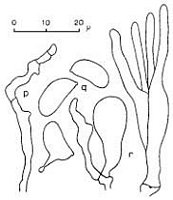|
 Exidiopsis tawa Exidiopsis tawa
SynonymsSebacina tawa
BiostatusPresent in region - Indigenous. Endemic
Images (click to enlarge)
Caption: Sebacina tawa: p, dikaryophysis; q, spores; r, basidia, |
Article: McNabb, R.F.R. (1969). New Zealand Tremellales - III. New Zealand Journal of Botany 7(3): 241-261 (http://www.rsnz.org/publish/abstracts.php).
Description: Fructifications soft-waxy to fleshy, resupinate,
thin, effused, indeterminate, originating as circular patches, coalescing to
form irregular areas to 5 cm in longest dimension, white to sordid white when
fresh, drying to a conspicuous white crust; margins concolorous, adnate. In
section 75-200 µm thick, consisting of basal layer and hymenium; granular material
abundant throughout fructification. Basal layer well defined, composed of distinct,
interwoven, septate hyphae 2-3.5 µm diam., lying parallel with substratum, clamp
connections absent. Hymenium composed of dikaryophyses and basidia; dikaryophyses
arising from basal hyphae or fertile hyphae, simple or sparingly branched, irregular,
often irregularly subclavate and to 7 µm diam., septate; probasidia clavate,
typically distinctly stalked, proliferating through or near basal clamp connections,
17.5-24.7-(27) x 7.8-11.7 µm, becoming longitudinally cruciate-septate, longitudinal
septa often diverging basally to delimit inflated apical portion from stalk;
sterigmata cylindrical, to 30 x 2.5-3 µm. Basidiospores cylindrical, curved-cylindrical,
or occasionally ovate and flattened on one side, hyaline, apiculate, 11-14.3
x 4.8-6.8 µm. Germination by repetition.
Habitat: Dead angiosperm wood.
Notes: The absence of both cystidia and gloeocystidia
indicate that this species belongs in sect. Sebacina.
The morphology of the basidia varies within
the single collection. The majority possesses stalks formed by divergence of
the longitudinal septa in basal regions, but a number of basidia lacking stalks
are also present. An interesting feature of S. tawa is the absence of
clamp connections on the internal hyphae except at the base of the basidia.
S. tawa does not appear to be closely related to any of the species included
in Exidiopsis by Wells (1961). The species is characterised by the simply
septate internal hyphae, typically stalked basidia with basal clamp connections,
and cylindrical to curved-cylindrical spores.
|